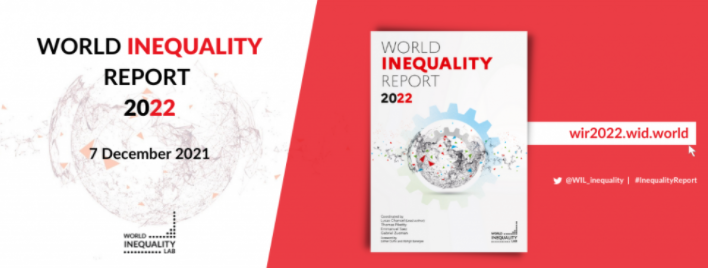
The World Inequality Report 2022 presents the most up-to-date and complete data on the various facets of inequality worldwide as of 2021: global wealth, income, gender and ecological inequality. The analysis is based on several years’ work by more than one hundred researchers from around the world, and will be published by the World Inequality Lab. The data is available in the most complete database on economic inequality, the World Inequality Database. The report includes a foreword by 2019 economic Nobel prize laureates Abhijit Banerjee & Esther Duflo.
The World Inequality Report 2022, the figures and datasets are available on the companion website of the report: //wid.world
IN A NUTSHELL
In 2021, after three decades of trade and financial globalization, global inequalities remain extremely pronounced: they are about as great today as they were at the peak of Western imperialism in the early 20th century. In addition, the Covid pandemic has exacerbated even more global inequalities. Our data shows that the top 1% took 38% of all additional wealth accumulated since the mid-1990s, with an acceleration since 2020. More generally speaking, wealth inequality remains at extreme levels in all regions (see figure 1.1)
“The COVID crisis has exacerbated inequalities between the very wealthy and the rest of the population. Yet, in rich countries, government intervention prevented a massive rise in poverty, this was not the case in poor countries. This shows the importance of social states in the fight against poverty.”, explains Lucas Chancel, lead author of the report.
Gabriel Zucman states: “The World Inequality Reports addresses a critical democratic need: rigorously documenting what is happening to inequality in all its dimensions. It is an invaluable resource for students, journalists, policymakers, and civil society all over the world.” Lucas Chancel adds “If there is one lesson to be learnt from the global investigation carried out in this report, it is that inequality is always political choice.”
KEY MESSAGES
- MENA is the most unequal region in the world, Europe has the lowest inequality levels.
- Nations have become richer, but governments have become poor, when we take a look at the gap between the net wealth of governments and net wealth of the private and public sectors.
- Wealth inequalities have increased at the very top of the distribution. The rise in private wealth has also been unequal within countries and at the world level. Global multimillionaires have captured a disproportionate share of global wealth growth over the past several decades: the top 1% took 38% of all additional wealth accumulated since the mid-1990s, whereas the bottom 50% captured just 2% of it.
- Gender inequalities remain considerable at the global level, and progress within countries is too slow
- Ecological inequality: our data shows that these inequalities are not just a rich vs. poor country issue, but rather a high emitters vs low emitters issue within all countries.
As explains Lucas Chancel “Global economic inequality fuels the ecological crisis and makes it much harder to address it. It’s hard to see how we can accelerate efforts to tackle climate change without more redistribution of income and wealth”.

DATA AND DATA VISUALIZATION
Wealth and income comparator: interface for users to check where they rank on the wealth distribution– similar to the income comparator available here: //wid.world/simulator
Wealth tax simulator: interface where users will be able to design a wealth tax by adjusting thresholds and tax rates, and eventually to measure the revenue generated and the impact on wealth inequalities. //wid.world/world-wealth-tax-simulator/
Data transparency: The Inequality Transparency Index gives an accurate picture of the availability and quality of income and wealth inequality data for each country.
";

.jpg)